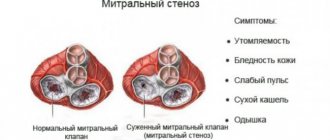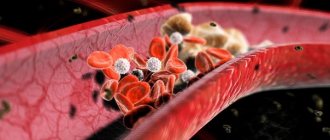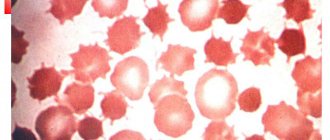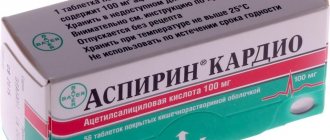Published: 07/23/2021 14:15:00 Updated: 07/23/2021
Atherosclerosis is a systemic disease that primarily affects the arteries. Cholesterol is deposited in the walls of blood vessels, resulting in the formation of plaques that interfere with normal blood flow. Internal organs experience a lack of oxygen and nutrients, and with the slow progression of the pathology, their work is gradually disrupted. In the case of acute thrombosis with complete blockage of blood flow, severe complications may develop - myocardial infarction, stroke, gangrene of the lower extremities and other dangerous pathologies.
What it is
Atherosclerosis is one of the most common chronic arterial diseases. Because of it, an atherosclerotic plaque of cholesterol (cholesterol) forms in the wall of the vessel. These plaques narrow the lumen of the vessel, which affects blood flow, and in extremely advanced cases, plaques can completely block the blood flow. If this happens in a large artery, then the situation is fraught with serious complications, including death: cardiovascular diseases have been one of the main causes of mortality for many years. In addition, the presence of a plaque in a vessel changes the flow of blood: turbulence appears, which contributes to the formation of blood clots (platelet sticking together). The appearance of blood clots poses a risk of their breaking off and clogging the vessel in a narrow place.
Stages (stages) of disease development (pathogenesis of atherosclerosis).
Fat streak stage.
Small lipid spots (only one or two millimeters) are immediately present on the walls of the vessel. Then they grow and “unite” with each other. Macrophages destroy them and transform into foam cells, from which fatty stripes appear. This is a normal process, the presence of which does not in any way indicate that a person may develop atherosclerosis in the future.
Stage of fibrous plaques.
The growth of connective tissue develops from fatty stripes, from which fibrous plaques are subsequently “born”. Initially, they are not solid and can be dissolved - with early detection and assistance provided to the patient. Later, fibrous plaques harden as calcium salts are deposited in them.
Stage of complex disorders.
The next stage is a violation of the integrity of fibrous plaques: cracks and tears appear on them. Platelets attach to such a plaque, causing partial or complete blockage of the vessel.
Causes and prevention of atherosclerosis
The cause of atherosclerosis is a disorder in fat metabolism - the accumulation of cholesterol (namely low-density lipoproteins) in excess quantities. Cholesterol is necessary for the body because... participates in many important processes such as the production of certain hormones, and is also part of the cell membrane. With a genetic predisposition to the accumulation of cholesterol, with an unbalanced diet, this substance becomes too much, the body cannot cope with its breakdown, and the excess begins to be deposited in the walls of blood vessels, leading to atherosclerosis.
Factors contributing to the development of atherosclerosis are considered to be: high blood pressure, diabetes mellitus, excess weight, stress, smoking, alcohol, age over 50 years. It is worth noting that the development of the disease often begins at a young age, and by the age of 50-60 the main symptoms appear.
A good method of preventing atherosclerosis is an active lifestyle, balanced physical activity and the fight against excess weight, if present.
Most resources also offer a balanced diet, or more precisely, reducing the consumption of animal fats as the main method of preventing atherosclerosis, i.e. the appearance of excess cholesterol. But some studies indicate that vegetable fats and carbohydrates can provoke an increase in blood cholesterol levels. Therefore, in your approach to your own nutrition, you should be guided by common sense and moderation. Both animal and vegetable fats are necessary for the body to function comfortably, and their excess (like an excess of any other substances) can lead to lipid metabolism disorders. But all researchers agree that consuming vegetables and fruits, adding fish to the diet, and moderate calorie intake are key and proven methods for preventing problems with blood vessels and more.
Treatment
Treatment of atherosclerosis begins with correction of diet and lifestyle changes.
All patients are recommended to lose weight, moderate physical activity, and quit smoking and alcohol. Often the cause of atherosclerosis is a nutritional factor, so diet plays a very important role. To reduce the concentration of cholesterol in the blood, it is important to avoid meat broths, fatty, salty, smoked foods, semi-finished products, spicy, spicy, fried foods, and limit the consumption of table salt.
Prohibited products include:
- sugar;
- confectionery, sweets;
- mayonnaise, tomato and other store-bought sauces;
- bakery products made from wheat flour;
- offal;
- sweet carbonated drinks;
- industrially produced juices and nectars;
- cocoa;
- canned meat and fish;
- dried fruits high in sugars;
- strong coffee and tea.
It is recommended to eat split meals five times a day, including a sufficient amount of fiber, protein (lean meats and fish, low-fat cottage cheese), fresh vegetables (except potatoes), fruits, and dairy products.
Drug therapy is aimed at:
- decreased cholesterol synthesis (statins, fibrates);
- decreased absorption of fats from food (cholesterol absorption inhibitors, bile acid sequestrants);
- prevention of thromboembolic complications (antiplatelet agents);
- relief of symptoms of atherosclerosis (painkillers, antispasmodics).
To determine indications for surgical treatment, the degree of disruption of blood flow in the vessel is determined.
An overlap of its lumen of less than 50% is considered hemodynamically insignificant; with stenosis of 50-70%, only drug therapy is usually carried out. Correction of arterial obstruction surgically must be performed in the third stage of atherosclerosis and narrowing of the lumen by more than 70%. There are two main types of surgical intervention:
- Balloon angioplasty. A balloon is inflated inside the affected vessel, while the atherosclerotic plaque is flattened and evenly distributed along the artery wall. At the end of the manipulation, the device is removed.
- Arterial stenting. During the operation, a thin lattice cylinder is inserted and opened in the area of narrowing. It also presses against the plaque, but remains in the lumen of the vessel, gradually growing into its endothelium.
Diagnostics
To diagnose atherosclerosis, both laboratory and instrumental methods can be used:
- general blood analysis;
- blood cholesterol level test;
- angiography (injection of a contrast agent into the blood, which reflects X-ray radiation and gives the specialist a detailed map of the condition of the vessels of the entire body);
- CT, MRI;
- coronary angiography (to study the coronary arteries);
- ECG, echocardiography (echocardiography);
- Holter ECG monitoring (to detect disturbances in heart rhythms);
- Ultrasound (to study the condition of the aorta, kidney vessels, heart).
Diagnostics usually does not cause problems for an experienced doctor - for this, our center has all the necessary equipment. After all, modern high-tech devices will be required - the better the equipment, the more detailed the examination data will be, which will help the doctor choose the optimal treatment method.
Vessels susceptible to atherosclerosis
With atherosclerosis, large main arteries are affected - the aorta and its branches.
Among the sections of the aorta, the abdominal aorta is most susceptible to atherosclerosis. Clinically significant atherosclerosis of the aortic arch and thoracic aorta is much less common. From the peripheral arteries and directly the branches of the aorta, the following should be distinguished:
- coronary (coronary) vessels,
- nourishing the heart,
- brachiocephalic arteries (BCA),
- subclavian arteries,
- common and internal carotid arteries (ICA),
- vertebral arteries,
- arteries of the limbs,
- renal arteries,
- celiac trunk,
- mesenteric arteries.
When several arterial basins are affected, they speak of generalized (widespread) atherosclerosis. Most often, atherosclerosis affects the coronary, brachiocephalic basins, as well as the vessels supplying blood to the lower extremities.
Atherosclerosis of the cerebral arteries
When cholesterol plaques form and the arteries of the brain narrow, the brain cells experience a lack of blood and nutrients. The following symptoms may indicate this condition:
- periodic dizziness,
- noise in ears,
- headache,
- increased fatigue,
- disturbances in coordination of movements.
The narrowing of the main carotid artery supplying the brain is identified as a separate diagnosis - carotid artery stenosis. Damage to the vessels supplying the brain carries the threat of a serious disease - ischemic stroke of the brain.
Atherosclerosis of heart vessels symptoms
Symptoms depend on which organ suffers most from lack of blood circulation. At the initial stage there are no special symptoms. Significant problems with blood supply and organ function arise if the lumen of the cardiac artery closes the passage by half. Common symptoms of the disease include:
- respiratory disorders, pain during breathing;
- feeling of pressure on the chest;
- violations of movement coordination;
- pale skin;
- sleep problems, lethargy.
This is a systemic disease. Accordingly, atherosclerosis affects the major highways through which blood is transported. It is for this reason that the manifestations of the disease can be different. As a rule, the heart, brain, and limbs suffer from atherosclerosis.
Get a free consultation Consultation does not oblige you to anything
Causes of atherosclerosis of heart vessels
The following reasons for the development of atherosclerosis of the heart vessels are identified: smoking, high blood pressure, as well as high cholesterol, diabetes mellitus. However, experts identify the main cause of the development of this disease - a disorder of cholesterol metabolism. The formation of atherosclerosis is a natural process. It begins in adolescence.
Diagnostics
Diagnosing atherosclerosis is relatively simple. A more difficult task is to clarify the localization of the process, as well as to determine the source of the lesion. Diagnostic methods include: taking an anamnesis, examining the patient using special functional tests, as well as instrumental studies and laboratory tests. Depending on the clinical picture, the treating doctor determines the most appropriate diagnostic methods.
Atherosclerosis of the arteries of the lower extremities
Damage to the arteries of the lower extremities is called obliterating atherosclerosis. People over 65 years of age, especially men, are susceptible to it. This disease manifests itself in the following symptoms:
- pain in the calves, cramps at rest;
- pain when walking, causing you to limp;
- numbness in the legs, fatigue when walking;
- the appearance of non-healing wounds, and in advanced cases - ulcers.
If you do not consult a doctor in the presence of such symptoms, then there will be a threat of limb amputation as the only treatment measure for extremely advanced cases of obliterating atherosclerosis.
How is atherosclerosis treated, what options exist?
For atherosclerosis, treatment is carried out comprehensively. A person must adhere to a diet. The diet is drawn up by a doctor, limiting fatty foods (primarily animal fats), simple carbohydrates and salt, and the person must also give up bad habits - smoking and drinking alcohol, and perform light physical activity (therapeutic exercises). In addition, the patient begins taking a course of medications, the task of which is to remove excess cholesterol from the human body, as well as aimed at reducing the activity of the body’s “production” function of cholesterol. If the above steps do not work, as well as in the case of a high probability of arterial blockage, then the patient is prescribed surgical intervention.
Unfortunately, atherosclerosis is an irreversible disease and it is completely impossible to cure it.
Atherosclerosis of the coronary arteries
Atherosclerosis of the coronary arteries (which bring blood to the tissues of the heart) is one of the main causes of coronary heart disease and myocardial infarction: when the disease affects the vessels of the heart, heart muscle cells begin to die due to insufficient nutrition. And the risk of blood clot formation and vessel blockage only aggravates the situation. This condition is extremely dangerous, life-threatening and requires consultation with a doctor. You should pay special attention to possible symptoms:
- chest pain;
- feeling of heaviness, tightness in the chest;
- arrhythmia, i.e. fast or slow heartbeat;
- feeling of a sinking heart.
Do not underestimate the above symptoms. Let us remember that the risk of developing atherosclerosis is present in many people. Complications of the disease without proper treatment are so dangerous that you should consult a doctor, even if you are afraid of a confirmed diagnosis or surgery. Modern medicine has advanced far in the treatment of atherosclerosis of various localizations.
Complications
Atherosclerosis of the lower extremities is dangerous due to the development of gangrene, muscle atrophy, and thromboembolism of blood vessels of vital organs in the event of plaque rupture.
Cardiac complications with damage to the coronary vessels include myocardial infarction, focal dystrophy of the heart muscle, myocardiosclerosis, and coronary sclerosis.
With obstruction of the mesenteric arteries, ischemic colitis and intestinal gangrene are possible, and secondary arterial hypertension is possible in the renal arteries. Cerebral consequences include hemorrhagic and ischemic stroke, transient ischemic attacks, and atherosclerotic dementia.
An aortic aneurysm poses a danger to the patient's life, the rupture of which in most cases is fatal.
Why is atherosclerosis dangerous?
Atherosclerotic or, as they are also called, cholesterol plaques, gradually narrow the lumen of the arteries and make them less elastic. This creates an obstacle to normal blood flow and leads to insufficient blood supply to the feeding organ.
The narrowing of the lumen of a vessel by an atherosclerotic plaque is called stenosis, and complete blockage of the lumen is called occlusion. Symptoms of the disease begin to appear at a certain degree of arterial stenosis, in which case we can talk about stenosing vascular atherosclerosis. For example, if the arteries of the heart narrow, the blood flow to the heart muscle (myocardium) decreases. This can cause chest pain and shortness of breath, which can ultimately lead to a heart attack. Particles of atherosclerotic plaque can break off from the walls of the arteries and be transported with the blood to narrower vessels, completely blocking their lumen.
In addition, the danger of atherosclerosis lies in the fact that particles of atherosclerotic plaque can break off from the walls of the arteries and be transported with the blood to narrower vessels, blocking their lumen. Blood clots can form in the area of atherosclerotic plaques, partially or completely blocking the lumen of the artery. In such cases, there is an acute disruption of the blood supply to the feeding organ, which can lead to dangerous, often life-threatening complications. The described mechanisms are often the cause of stroke, myocardial infarction, thrombosis and obliterating atherosclerosis of the vessels of the lower extremities.
Who's at risk
All people are susceptible to atherosclerotic changes in blood vessels to one degree or another. It all depends on when atherosclerosis leads to serious complications - at 40 years old or at 80. Let’s consider the main groups of people who are at risk of encountering this problem earlier than others:
- People with arterial hypertension. High blood pressure is a damaging factor for blood vessels. When damaged, an inflammatory process develops, which is the main trigger for the appearance of cholesterol plaques.
- People with metabolic diseases. Lipid metabolism disorders, diabetes mellitus, and hormonal disorders are risk factors for the development of atherosclerosis.
- People suffering from obesity. This factor, together with poor nutrition, is one of the main factors in the development of atherosclerosis.
- People leading a sedentary lifestyle. Physical inactivity impairs blood flow and also contributes to the development of congestion.
- Other factors. The development of atherosclerosis is also promoted by infectious diseases (sources of inflammation), unhealthy diet, stress, hereditary factors, and increased blood viscosity.
Important : atherosclerosis and cholesterol. Until the end of the last century, doctors believed that there was a direct connection between eating animal foods (which contain cholesterol) and atherosclerosis. It was believed that the more cholesterol you consumed, the higher the likelihood of disease. However, cholesterol alone is not enough for the development of atherosclerosis. If the walls of the arteries are not damaged, then no matter how much cholesterol circulates in the blood, there will be no atherosclerosis. In addition, the main amount of cholesterol is synthesized in the liver, so cholesterol introduced from outside has virtually no negative effect.
Determination of the ankle-brachial index
The ankle-brachial index (ABI) is an important indicator in the diagnosis of atherosclerotic vascular lesions. This is the ratio of blood pressure in the lower leg to the pressure in the arm. At certain ABI values, a professional physician can detect atherosclerosis of peripheral vessels in the early stages and prevent its development.
At the Center for Pathology of the Circulatory Organs, determining ABI takes no more than 1 minute using the Boso ABI-System 100 system, as well as the Japanese VaSera VS-1000 Fukuda Denshi sphygmomanometer. The procedure is a simultaneous measurement of pressure on the limbs and does not require special preparation of the patient.
For a detailed study of blood vessels, our equipment also measures the speed of propagation of the pulse wave. High speed is a signal to start treatment. This is a characteristic indicator for the development of atherosclerosis.
Diet for atherosclerosis
A diet for atherosclerosis should satisfy the following principles:
- Limit saturated fats. It is recommended for a person to reduce the amount of animal fats consumed. It is better to avoid fried meat, since frying occurs isomerization of fats. Because of this, the proportion of trans fats in fried meat increases, and it is advisable to completely avoid them.
- More vegetables and fruits. Eat more plant-based foods because they contain fiber, which can normalize blood sugar and lipids and improve digestion.
- Limiting salt and sugar. Excessive consumption of simple carbohydrates (sugar, sweets, sugary drinks, including natural juice) contributes to obesity and metabolic disorders. And too much salt in the diet increases the risk of cardiovascular disease in general.
It is extremely important to follow the rules of eating behavior. Never overeat, eat slowly and chew your food thoroughly. Regarding the number of meals, consult your doctor. For some patients, 2-3 meals a day are enough, while others need split meals - up to 4-6 times in small portions.
Mechanism of disease development
Let's take a closer look at the mechanisms and three stages of development of atherosclerosis, where it all begins and how it ends.
First stage
Initially, fatty streaks and spots form on the inner walls of the arteries. Due to the inflammatory process, the arterial wall swells, becomes loose and attracts more and more lipid fractions.
Second phase
Atherosclerotic plaques are formed from connective tissue and lipids. At this stage, the plaques are still soft, so with strong blood flow they can rupture and clog smaller vessels.
Third stage
At the last stage, calcium accumulates in the plaques, which makes them harder.
Until now, there are ongoing discussions regarding the mechanisms of development of atherosclerosis. It is assumed that the appearance of atherosclerotic plaques is also associated with certain infections. The role of mutations is also being considered, in which the walls of the arteries become more vulnerable to damaging factors.
Treatment of atherosclerosis at the Innovative Vascular Center
Our center was created as a clinic for modern treatment of atherosclerosis and its complications. In our clinic you can consult an experienced vascular surgeon and undergo the necessary instrumental examination. Receive recommendations for conservative treatment of uncomplicated vascular lesions, but the main thing is to fully cure critical ischemia with the help of vascular surgery.
The methods of vascular surgery used in our clinic have no analogues in Russia in terms of their effectiveness in the treatment of critical ischemia against the background of obliterating atherosclerosis. We focus on minimally invasive and microsurgical interventions, which have not yet become widespread in our country. We are able to save a leg in case of critical ischemia due to atherosclerotic blockage in 98% of all patients. We achieve such results thanks to reasonable approaches to treatment, impeccable attitude towards the interests of our patients, collegial decisions taking into account the opinions of related specialists and excellent diagnostic and treatment equipment.








